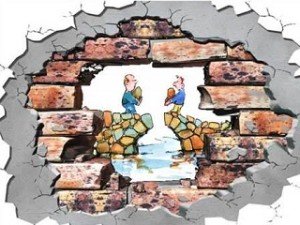
Fusion of horizons and dialogue
It is possible to speak of dialogue without exercising any dialogue process,  it is a common discourse because everyone wants to claim for themselves the universality of the discourse itself, but this is a rupture within the process of constructing a collective discourse.
it is a common discourse because everyone wants to claim for themselves the universality of the discourse itself, but this is a rupture within the process of constructing a collective discourse.
The important thing about walls is that behind them there are those who build bridges and these inevitably give more mobility than the walls, and thus find easier way.
In philosophy it is what is called a fusion of horizons, while the discourse of anti-dialogical dialogue closes in an airtight circle of the approval of its peers, the process that goes beyond dialogue, since it is hermeneutic, it builds the road of truth that is Safe and paved.
Hermetic closure in theory / practice, idealistic discourse of modernity, understanding, as man’s most basic mode of being and its insertion into the horizon of practical life indicates one is a much more key issue in the hermeneutical tradition.
Far from being idealistic, it is possible to speak of hermeneutic engagement with a new “praxis” that happens as it develops an open relationship with the discourse of the Other.
Gadamer, one of the architects of this new dialogical articulation, sees in many cases that reflection on what praxis does not have should replace our immersion within the logic of life, as long as it is achievable and objective in facts seen and not just imagined.
For the philosopher of the new hermeneutics, “understanding must be thought less as an action of subjectivity than a participation in an event of tradition, a process of transmission in which the past and present are constantly mediated” (Gadamer, 2003).
David Waberman, one of Gadamer’s readers, states that: “Understanding is generally a case of merging horizons,” and in the case of understanding the past, a “thoughtful mediation” Of the present (Waberman, 1999).
Thus the sense we give of a text we are reading or even (perhaps even more so) a work of art, we should not pretend to reconstruct the author’s original intention, but to understand it in such a way that its truth is manifested to us.
Regardless of our historical situation, we are all living it at the same time, and this necessarily involves an ever-differentiated understanding, and always differently from the way the work was originally intended, as Waberman also sees it, so we can “talk” about If we are open to the horizon of the other, most of the time this is done without the dialogue of the Other different, but of the other that repeats my own discourse, without the necessary dialogue.The dialogical difference is that one builds walls, even stating the opposite, and the other builds bridges, even with stones thrown.
Gadamer, H.G. Truth and Method, 2nd edition, London/New York, Continuum. 1975.
WEBERMAN, David. Reconciling Gadamer’s non-intentionalism with Standard conversational goals. In The Philosophical Forum, v. XXX, n.4, p. 317, dez/1999,









